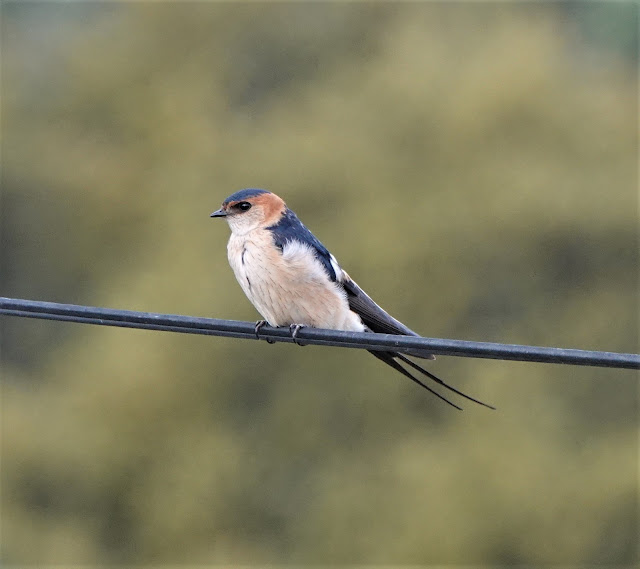Lockdown Birding Part 14
 |
| Red-rumped Swallow (Martin Kelsey) |
Only infrequently seen at the start of the lockdown, Red-rumped Swallows are now close confidents of our confinement. They are happy to sit on the balcony railing as I stand just a few feet away by. They chortle in their friendly budgerigar manner whilst perched in the shade next to our open kitchen door. I am not sure where this pair has chosen to nest. The old nest beside the kitchen still stands but over the last years has seen other occupants: Blue Tits and Wrens. It is now full of holes and stuffed with moss, an alien nest-lining for the Red-rumped Swallows, which gather small feathers floating airbourne.
The Stonechats must now be on their second brood, and the Barn Swallows in the toolshed are using the same nest from which their three first-brood chicks successfully fledged. There are family parties of Blue Tits working the bushes. Their ashy-smudged juveniles inquisitively picking at the bark of the twigs. The Nightingale is paired up and I suspect nesting at the edge of the garden.
 |
| Stonechat from the balcony (Martin Kelsey) |
We have now completed eight weeks of lockdown and although in the final week we have been permitted to take an hour's walk each day, I have maintained my balcony birding as an important and much anticipated daily routine. Tomorrow the lockdown relaxes further and for the first time since mid-March, I shall be able to go birding away from the village - provided I stay within the provincial boundaries. Given the prospect of being able to venture further afield, I suspect that this will be the final Lockdown Birding blog, unless God forbid, the health situation takes a turn for the worst.
Since 15th March, I have logged almost 60 hours of lockdown balcony birding and recorded 77 species. These have included no fewer than 14 species of diurnal bird of prey (not counting three species of owl), among which have been Egyptian Vulture, Montagu's Harrier and Honey Buzzard. The latter was one of my hoped-for species - only once before in 15 years had I seen one from the house. It features as one of the highlights of the whole period.
Interestingly, despite this long period of active spring that my attention has been focused on the birds of the garden, I did not see anything that I had not previously recorded at home. I am rather surprised by this, but I guess it reflects the fact that we have been here 16 years and over that time have seen pretty much most that is likely to turn up close to the house in the spring. I have no doubt at all that had I being able to invest in sound recording equipment I could easily have added several more species of nocturnal migrants.
 |
| Small-flowered Tongue Orchid (Martin Kelsey) |
I have also noted down the butterflies seen, but the generally damp and cool conditions that have prevailed over the two months mean that my list is a modest 13 species. But these very same conditions, however, have ensured a remarkable show of wild flowers around the garden and olive grove. The highlight here, certainly, was the discovery of a colony of Small-flowered Tongue Orchids, literally just a few metres from where I am sitting to write this blog.
I have always valued our immediate surroundings for the nature that is granted at our doorstep, the sound of a Blackbird singing and the gentle flow of spring colours, but never as much as over the last two months. It has provided solace, comfort and reassurance. Now this balcony will continue to be a treasured local patch as part of my birding in Extremadura.



Comments
Brian Banks
As someone who has had the pleasure of staying with you on several occasions your wonderfully descriptive blogs have bought back some very happy birding memories.
Many thanks
Pat & Judy Hayes
We have a total collapse in house martins this year.I would be interested to know if it is the same with you.
Best wishes Ed Collins